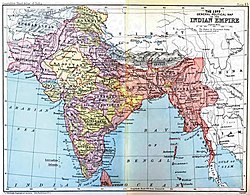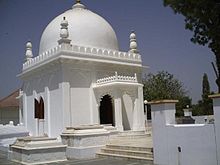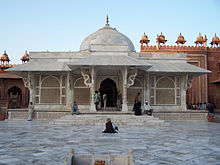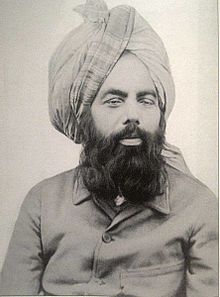Islam in India (2 of 3):

Partition of India

Khan Abdul Ghaffar Khanwith Gandhi in 1930. Also known as Frontier Gandhi, Khan led the non-violent opposition against the British Raj and strongly opposed thepartition of India.
Main article: Partition of India
The partition of India (Hindi: हिन्दुस्तान का बटवारा,Urdu: تقسیم ہند) was the partition of British India on the basis of religious demographics. This led to the creation of the sovereign states of the Dominion of Pakistan (that later split into the Islamic Republic of Pakistan and the People's Republic of Bangladesh) and theUnion of India (later Republic of India). The Indian Independence Act 1947 had decided 15 August 1947, as the appointed date for the partition. However, Pakistan celebrates its day of creation on 14 August.
The partition of India was set forth in theIndian Independence Act 1947 and resulted in the dissolution of the British Indian Empireand the end of the British Raj. It resulted in a struggle between the newly constituted states of India and Pakistan and displaced up to 12.5 million people with estimates of loss of life varying from several hundred thousand to a million (most estimates of the numbers of people who crossed the boundaries between India and Pakistan in 1947 range between 10 and 12 million).[36] The violent nature of the partition created an atmosphere of mutual hostility and suspicion between India and Pakistan that plagues their relationship to this day.
The partition included the geographicaldivision of the Bengal province into East Bengal, which became part of the Dominion of Pakistan (from 1956, East Pakistan). West Bengal became part of India, and a similar partition of the Punjab province became West Punjab (later the Pakistani Punjab andIslamabad Capital Territory) and East Punjab(later the Indian Punjab, as well as Haryanaand Himachal Pradesh). The partition agreement also included the division of Indian government assets, including theIndian Civil Service, the Indian Army, theRoyal Indian Navy, the Indian railways and the central treasury, and other administrative services.
The two self-governing countries of India and Pakistan legally came into existence at the stroke of midnight on 14–15 August 1947. The ceremonies for the transfer of power were held a day earlier in Karachi, at the time the capital of the new state of Pakistan, so that the last British Viceroy, Lord Mountbattenof Burma, could attend both the ceremony in Karachi and the ceremony in Delhi. Thus,Pakistan's Independence Day is celebrated on 14 August and India's on 15 August.
After Partition of India in 1947, two-thirds of the Muslims resided in Pakistan (both east and West Pakistan) but a third resided in India.[37] Some critics allege that British haste in the partition process increased the violence that followed.[38] Because independence was declared prior to the actual Partition, it was up to the new governments of India and Pakistan to keep public order. No large population movements were contemplated; the plan called for safeguards for minorities on both sides of the new border. It was a task at which both states failed. There was a complete breakdown of law and order; many died in riots, massacre, or just from the hardships of their flight to safety. What ensued was one of the largest population movements in recorded history. According to Richard Symonds: At the lowest estimate, half a million people perished and twelve million became homeless.[39]
However, many argue that the British were forced to expedite the Partition by events on the ground.[40] Once in office, Mountbatten quickly became aware if Britain were to avoid involvement in a civil war, which seemed increasingly likely, there was no alternative to partition and a hasty exit from India.[40] Law and order had broken down many times before Partition, with much bloodshed on both sides. A massive civil war was looming by the time Mountbatten became Viceroy. After the Second World War, Britain had limited resources,[41] perhaps insufficient to the task of keeping order. Another viewpoint is that while Mountbatten may have been too hasty he had no real options left and achieved the best he could under difficult circumstances.[42] The historian Lawrence James concurs that in 1947 Mountbatten was left with no option but to cut and run. The alternative seemed to be involvement in a potentially bloody civil war from which it would be difficult to get out.[43]
Conservative elements in England consider the partition of India to be the moment that the British Empire ceased to be a world power, following Curzon's dictum: "the loss of India would mean that Britain drop straight away to a third rate power."[44]
Population
India's Muslim population is the world's third largest[45] and the world's largest Muslim-minority population.[46] Officially, India has the third largest Muslim population next toIndonesia and Pakistan.[47][48] India is home to 10% of the world's Muslim population. India has around 172 million Muslims (2011 census).[49][9] Estimates show India may have more Muslims than Pakistan, though 2016 census in Pakistan will give the exact figure,[50][51] as overall population of Pakistan is estimated at around 191.71 million .[10][52][53]
Muslim Populations ( Top 5 Countries) by PEW
- Data compiled as of 2011
Muslims represent a majority of the local population in Lakshadweep and Jammu and Kashmir. The largest concentration –about 47% of all Muslims in India, live in the three states of Uttar Pradesh, West Bengal, andBihar. High concentrations of Muslims are found in states of Assam, Kerala,Maharashtra, Jharkhand and Karnataka.
Muslim population by states
As of 2015,Muslims comprise the majority of the population in the only Indian state ofJammu and Kashmir and in a Union territoryLakshadweep. In 110 minority-concentrated districts, at least a fifth of the population are Muslim.[55]
- The Census 2011 results of Mao-Maram, Paomata and Purul Sub-divisions of Senapati district of Manipur were withheld due to administrative reasons. The figurs have now been finalized .
Population growth rate
Muslim Population Growth per Census
1981 Census: * Parts of Assam were not included in the 1981 Census Data due to violence in some districts.
1991 Census: ** Jammu and Kashmir was not included in the 1991 Census Data due to militant activity in the state.
2011 Census: *** Estimated populations of Muslims in India as religious demographics has still not been released by government of India.
Muslims in India have a much higher total fertility rate (TFR) compared to that of other religious communities in the country.[60]Because of higher birthrates the percentage of Muslims in India has risen from about 10% in 1951 to 14.4% by 2013. The Muslim population growth rate is higher by more than 10% of the total growth compared to that ofHindus.[59] However, since 1991, the largest decline in fertility rates among all religious groups in India has occurred among Muslims.[61] The Population Growth rate is also attributable to the fact that majority of Muslim populations are concentrated in the states that are lagging behind in social reforms and services which have shown higher birth rates than other states. However, the Sachar Committee Report shows that the Muslim Population Growth has slowed down and will be on par with national averages.[62]
Social and economic reasons behind population growth
Demographers have put forward several factors behind high birthrates among Muslims in India. According to sociologists Roger and Patricia Jeffery, socio-economic conditions rather than religious determinism is the main reason for higher Muslim birthrates. Indian Muslims are poorer and less educated compared to their Hindu counterparts.[63] Noted Indian sociologist, B.K. Prasad, argues that since India's Muslim population is more urban compared to their Hindu counterparts, infant mortality rates among Muslims is about 12% lower than those among Hindus.[64]
However, other sociologists point out that religious factors can explain high Muslim birthrates. Surveys indicate that Muslims in India have been relatively less willing to adoptfamily planning measures and that Muslim women have a larger fertility period since they get married at a much younger age compared to Hindu women.[65] A study conducted by K.C. Zacharia in Kerala in 1983 revealed that on average, the number of children born to a Muslim woman was 4.1 while a Hindu woman gave birth to only 2.9 children. Religious customs and marriage practices were cited as some of the reasons behind the high Muslim birth rate.[66]According to Paul Kurtz, Muslims in India are much more resistant to modern contraception than are Hindus and, as a consequence, the decline in fertility rate among Hindu women is much higher compared to that of Muslim women.[60][67]The National Family and Health survey conducted in 1998–99 highlighted that Indian Muslim couples consider a substantially higher number of children to be ideal for a family as compared to Hindu couples in India.[68] The same survey also pointed out that percentage of couples actively using family planning measures was more than 49% among Hindus against 37% among Muslims.
Denominations
There are many denominations amongst Indian Muslims, the majority belong to theSunni branch of Islam, while a substantial minority belong to the Shia branch. There are also small minorities of Ahmadiyya andQuranists. Many Indian Muslim communities, both Sunni and Shia, are also considered to be Sufis.
Sunni
Indian Sunnis largely follow the Hanafi school of Islamic law.
The majority of Indian Sunnis however follow the moderate Barelvi movement which was founded in 1904 by Ahmed Razi Khan of Bareilly in defense of traditional Islam as understood and practised in South Asia and in reaction to the reformist attempts of the Deobandi movement.[69][70] In the 19th century the Deobandi, a revivalist movement in Sunni Islam was established in India. It is named after Deoband a small town northeast of Delhi, where the original madrasa or seminary of the movement was founded. From its early days this movement has been influenced by Wahhabism.[71][72][73]
Shia
Shia Muslims are a large minority amongIndia's Muslims. However, there has been no particular census conducted in India with regards to sects, but Indian sources likeTimes of India and Daily News and Analysisreported Indian Shia population in mid 2005–2006 between 25% and 31% of entire Muslim population of India which accounts them in numbers between 40,000,000[74][75] to 50,000,000[76] of 157,000,000 Indian Muslim population.[77] However, as per an estimation of one reputed Shia NGO Alimaan Trust, India's Shia population in early 2000 was around 30 million with Sayyids comprising just a tenth of the Shia population.[78]According to some national and international sources Indian Shia population is the world's second-largest afterIran.[79][80][81][82][83][84][85][86][87]
Dawoodi Bohra
Main article: Dawoodi Bohra
Dawoodi Bohra' Ismailli Shia whose belief system originates in Yemen, evolved from theFatimid were persecuted due to their adherence to Fatimid Shia Islam – leading the shift of Dawoodi Bohra to India. After occultation of their 21st Imam Tayyib, they follow Dai as representative of Imam which are continued till date.
This community was established in Gujarat in the second half of the 11th century. According to legend, two travellers (Moulai Abadullah (formerly known as Baalam Nath) and Maulai Nuruddin (Rupnath)) from India went to the court of Imam Mustansir. They were so impressed that they converted and went back to preach in India. Abadullah was first Wali-ul-Hind (saint of India). He came across a married couple named Kaka Akela and Kaki Akela who became his first converts.
One Dai succeeded another until the 23rd Dai in Yemen. In India also Wali-ul-Hind were appointed by them one after another until Wali-ul-Hind Moulai Qasim Khan bin Hasan (11th and last Wali-ul-Hind, d.950AH,Ahmedabad).
Due to persecution by the local Zaydi Shi'aruler in Yemen, the 24th Dai, Yusuf Najmuddin ibn Sulaiman (d.1567 AD), moved the whole administration of the Dawat(mission) to India. The 25th Dai Jalal Shamshuddin (d.1567 AD) was first dai to die in India. His mausoleum is in Ahmedabad, India. The Dawat subsequently moved from Ahmedabad to Jamnagar[88] Mandvi, Burhanpur, Surat and finally to Mumbai and continues there to the present day, currently headed by 52nd Dai Mohammad Burhanuddin.
Asaf Ali Asghar Fyzee was a Bohra and 20th century Islamic scholar from India who promoted modernization and liberalization of Islam through his writings. He argued that with changing time modern reforms in Islam are necessary without compromising on basic "spirit of Islam".[75][89][90]
Khojas
The Khojas are a group of diverse people who converted to Islam in South Asia. In India, most Khojas live in the states of Gujarat,Maharashtra, Rajasthan and the city ofHyderabad. Many Khojas have also migrated and settled over the centuries in East Africa,Europe and North America. The Khoja were by then adherents of Nizari Ismailism branch of Shi'ism. In the late 19th and early 20th centuries, particularly in the aftermath of theAga Khan Case a significant minority separated and adopted Twelver Shi'ism orSunni Islam, while the majority remainedNizārī Ismā'īlī.[91]
Sufis
Main article: Sufism in India
Sufis (Islamic mystics) played an important role in the spread of Islam in India. They were very successful in spreading Islam, as many aspects of Sufi belief systems and practices had their parallels in Indian philosophical literature, in particular nonviolence andmonism. The Sufis' orthodox approach towards Islam made it easier for Hindus to practice. Hazrat Khawaja Muin-ud-din Chishti,Qutbuddin Bakhtiar Kaki, Nizam-ud-din Auliya,Shah Jalal, Amir Khusro, Sarkar Sabir Pak, Shekh Alla-ul-Haq Pandwi, Ashraf Jahangir Semnani, Sarkar Waris Pak, Ata Hussain Fani Chishti trained Sufis for the propagation of Islam in different parts of India. Once the Islamic empire was established in India, Sufis invariably provided a touch of colour and beauty to what might have otherwise been rather cold and stark reigns. The Sufi movement also attracted followers from theartisan and untouchable communities; they played a crucial role in bridging the distance between Islam and the indigenous traditions.Ahmad Sirhindi, a prominent member of theNaqshbandi Sufi advocated the peaceful conversion of Hindus to Islam. MaulanaAhmed Rida Khan contributed much in defending traditional and orthodox Islam in India through his work Fatawa Razvia.[92]
Ahmadiyya
Main article: Ahmadiyya Islam
The Ahmadiyya movement was founded in 1889 by Mirza Ghulam Ahmad of Qadian. He claimed to be the promised messiah andmahdi awaited by the Muslims and obtained a considerable number of followers initially within the United Provinces, the Punjab andSindh.[93] Ahmadis claim the Ahmadiyya movement to be the latter day revival and peaceful propagation of Islam and the movement has also been seen to have emerged as an Islamic religious response to the Christian and Arya Samaj missionary activity that was widespread in 19th century India. After the death of Ghulam Ahmad, hissuccessors directed the Ahmadiyya Community from Qadian which remained the headquarters of the community until 1947 with the creation of Pakistan. The movement has grown in organisational strength and in its own missionary programme and has expanded to over 200 countries as of 2014 but has received a largely negative response from mainstream Muslims who see it as heretical, due mainly to Ghulam Ahmad's claim to be a prophet within Islam.[94]
India has a significant Ahmadiyya population.[95] Most of them live in Rajasthan,Odisha, Haryana, Bihar, Delhi, Uttar Pradesh, and a few in Punjab in the area of Qadian. In India, Ahmadis are considered to be Muslims by the Government of India (unlike in neighbouring Pakistan). This recognition is supported by a court verdict (Shihabuddin Koya vs. Ahammed Koya, A.I.R. 1971 Ker 206).[96][97] There is no legislation that declares Ahmadis non-Muslims or limits their activities,[97] but they are not allowed to sit on the All India Muslim Personal Law Board, a body of religious leaders India's government recognises as representative of Indian Muslims.[98] Ahmadiyya are estimated to be from 60,000 to 1 million in India.[99]
Quranists
Non-sectarian Muslims who reject the authority of hadith, known as Quranists, Quraniyoon, or Ahle Quran, are also present in India. In South Asia during the 19th century, the Ahle Quran movement formed partially in reaction to the Ahle Hadith movement whom they considered to be placing too much emphasis on hadith. Many Ahle Quran adherents were formerly adherents of Ahle Hadith but found themselves incapable of accepting certain hadiths.[100] Notable Indian Quranists include Chiragh Ali, Aslam Jairajpuri, Khwaja Ahmad-ud-Din Amritsari, and Abdullah Chakralawi.[101]
Origins
The vast majority of the Muslims in India belong to Indian ethnic groups. However, some Indian Muslims were found with detectable, traceable, minor to some levels of gene flow from outside, primarily from the Middle East and Central Asia.[102][103][104]However, they are found in very low levels.[104] Sources indicate that the castes among Muslims developed as the result of the concept of Kafa'a.[105][106][107] Those who are referred to as Ashrafs (see also Sharif) are presumed to have a superior status derived from their foreign Arabancestry,[108][109] while the Ajlafs are assumed to be converts from Hinduism, and have a lower status. Actual Muslim social practice, including in India, points to the existence of sharp social hierarchies that numerous Muslim scholars have sought to provide appropriate Islamic sanction through elaborate rules of fiqh associated with the notion of kafa'a.[citation needed]
Most prominent Muslim scholars such as Maulana Ahmad Raza Khan Barelvi and Maulana Ashraf Ali Thanvi have championed the notion of caste superiority based on birth.[citation needed] It is argued that Muslims ofArab origin (Sayyeds and Shaikhs) are superior to non-Arab or Ajami Muslims, and so while a man who claims Arab origin can marry an Ajami woman, the reverse is not possible.[citation needed] Likewise, they argue, aPathan Muslim man can marry a Julaha(Ansari) Mansuri (Dhunia,) Rayin (Kunjra) or Quraishi (Qasai or butchers) woman, but an Ansari, Rayin, Mansuri and Quraishi man cannot marry a Pathan woman since they consider these castes to be inferior to Pathans.[citation needed]
Many of these ulema also believed that it is best to marry within one own caste. The practice of endogamous marriage in one's caste is strictly observed in India.[110][111] In two of the three genetic studies referenced here, in which is described that samples were taken from several regions of India's Muslim communities, it was again found that the Muslim population was overwhelmingly similar to the local non-Muslims associated, with some having minor but still detectable levels of gene flow from outside, primarily from Iran and Central Asia, rather than directly from the Arabian peninsula.[103]
A research regarding the comparison of Y chromosomes of Indian Muslims with other Indian groups was published in 2005.[103][104]In this study 124 Sunnis and 154 Shias of Uttar Pradesh were randomly selected for their genetic evaluation. Other than Muslims, Hindu higher and middle caste group members were also selected for the genetic analysis. Out of 1021 samples in this study, only 17 samples showed E haplogroup and all of them were Shias. The very minor increased frequency however, does place these Shias, solely with regards to their haplogroups, closer to Iraqis, Turks and Palestinians.[103][104]
Continued......







2 comments:
Thanks for the nice article
The articles based on Sufism is really nice.
Post a Comment